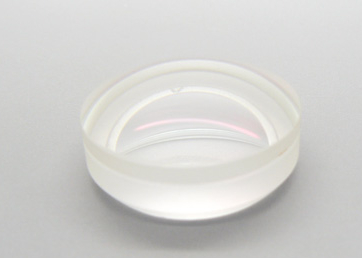Cylindrical lens : a complete guide
Cylindrical lenses are less common than spherical lenses, but are still wide spread in many Photonics applications, below you’ll find a complete guide to let you learn more about it:
What is a cylindrical lens ?
A cylindrical lens is a lens with at least one optical surface has the shape of a section of a cylinder. While spherical lenses surfaces are defined from a fix center of curvature and a radius, cylinder lens shape are made along a central axis with a fix radius of curvature.

Illustration of a convex and a concave cylindrical lens.
What are the types of cylindrical lens ?
Like other lenses a cylindrical lens is defined from the shape of it’s optical surfaces :
| Cylindrical lens type | Detail |
|---|---|
| PCV – Plano-concave lens | one flat surface and a concave cylindrical surface. Focus light on one line. |
| PCX – Plano-convex cy | one flat surface and a concave cylindrical surface. Expend the light in one direction. |
| Biconvex | both sides with convex cylindrical shape (can be of different radius of curvature) |
| Biconcave | both sides with concave cylindrical shape (can be of different radius of curvature) |
| Doublet | Achromatic cylindrical lens. |
Lenses outer shape may be cut in round shape of square shape.
Contact us to get more information or a quotation :
What are the material used to make cylindrical lens ?
Most of the optical raw materials may be used are :
- Optical glass : BK7, H-K9L, B270 from Schott, Corning, Ohara or CDGM
- Fused silica : JGS1, JGS2, Corning 7980
- IR materials : Ge, Si, MgF2, CaF2
- Other materials : Sapphire, Optical plastics
What are the usage of cylindrical lens ?
Cylindrical lenses are mainly used to focus a incident light signal into a one dimension line, below are the most commun applications :
- Laser scanning (when the scan signal should form a line)
- Vision quality control (concentrate the lighting on one dimension)
- Metrology
- Ophtalmology
- Defense
- Sensors
- Lighting
How is polished a cylindrical lens ?
Cylindrical polishing of a lens doesn’t require rotational polishing machines, but specific polishing equipment working way and forth in one direction.

Cylindrical lens polishing pad
To guaranty a good surface aspect, polishing cylindrical lens use specific polishing toolings and polishing pads. See above an example of such a tool, you’ll notice that for cost saving, several cylindrical glass lenses are polish at the same time.
What is the the difference between a spherical lens and a cylindrical lens ?
The main difference stands in the way the light rays are deviated through it. Spherical lens tends to focus on a point whereas cylindrical ones focus on a one dimension line.
Whereas a spherical lens is perfectly symmetric along a central rotational axis, it is not the case for the cylindrical ones. Which means while the rotation angle by which the lens is used has no impact for the first one but will impact the optical system for the former one. Assembly of cylindrical lenses are therefore subject to one more constraint.







